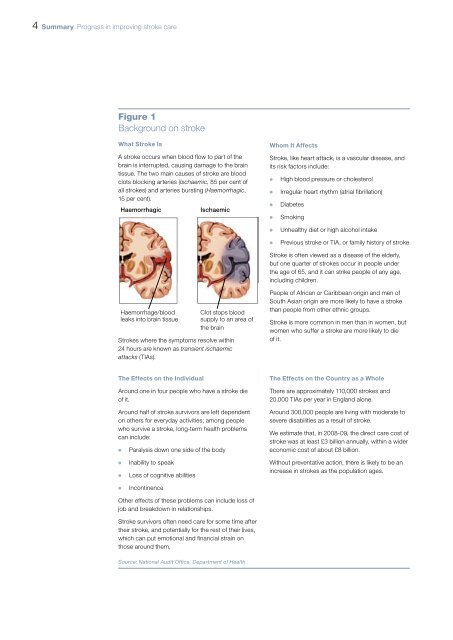Progress in improving stroke care - National Audit Office
Progress in improving stroke care - National Audit Office
Progress in improving stroke care - National Audit Office
You also want an ePaper? Increase the reach of your titles
YUMPU automatically turns print PDFs into web optimized ePapers that Google loves.
4 Summary <strong>Progress</strong> <strong>in</strong> improv<strong>in</strong>g <strong>stroke</strong> <strong>care</strong>Figure 1Background on <strong>stroke</strong>What Stroke isA <strong>stroke</strong> occurs when blood flow to part of thebra<strong>in</strong> is <strong>in</strong>terrupted, caus<strong>in</strong>g damage to the bra<strong>in</strong>tissue. The two ma<strong>in</strong> causes of <strong>stroke</strong> are bloodclots block<strong>in</strong>g arteries (Ischaemic, 85 per cent ofall <strong>stroke</strong>s) and arteries burst<strong>in</strong>g (Haemorrhagic,15 per cent).HaemorrhagicIschaemicWhom it affectsStroke, like heart attack, is a vascular disease, andits risk factors <strong>in</strong>clude:¬¬¬¬High blood pressure or cholesterolIrregular heart rhythm (atrial fibrillation)DiabetesSmok<strong>in</strong>g¬¬Unhealthy diet or high alcohol <strong>in</strong>takePrevious <strong>stroke</strong> or TIA, or family history of <strong>stroke</strong>Stroke is often viewed as a disease of the elderly,but one quarter of <strong>stroke</strong>s occur <strong>in</strong> people underthe age of 65, and it can strike people of any age,<strong>in</strong>clud<strong>in</strong>g children.Haemorrhage/bloodleaks <strong>in</strong>to bra<strong>in</strong> tissueClot stops bloodsupply to an area ofthe bra<strong>in</strong>Strokes where the symptoms resolve with<strong>in</strong>24 hours are known as transient ischaemicattacks (TIAs).People of African or Caribbean orig<strong>in</strong> and men ofSouth Asian orig<strong>in</strong> are more likely to have a <strong>stroke</strong>than people from other ethnic groups.Stroke is more common <strong>in</strong> men than <strong>in</strong> women, butwomen who suffer a <strong>stroke</strong> are more likely to dieof it.the effects on the <strong>in</strong>dividualAround one <strong>in</strong> four people who have a <strong>stroke</strong> dieof it.Around half of <strong>stroke</strong> survivors are left dependenton others for everyday activities; among peoplewho survive a <strong>stroke</strong>, long-term health problemscan <strong>in</strong>clude:¬Paralysis down one side of the bodythe effects on the Country as a WholeThere are approximately 110,000 <strong>stroke</strong>s and20,000 TIAs per year <strong>in</strong> England alone.Around 300,000 people are liv<strong>in</strong>g with moderate tosevere disabilities as a result of <strong>stroke</strong>.We estimate that, <strong>in</strong> 2008-09, the direct <strong>care</strong> cost of<strong>stroke</strong> was at least £3 billion annually, with<strong>in</strong> a widereconomic cost of about £8 billion.¬¬¬Inability to speakLoss of cognitive abilitiesIncont<strong>in</strong>enceWithout preventative action, there is likely to be an<strong>in</strong>crease <strong>in</strong> <strong>stroke</strong>s as the population ages.Other effects of these problems can <strong>in</strong>clude loss ofjob and breakdown <strong>in</strong> relationships.Stroke survivors often need <strong>care</strong> for some time aftertheir <strong>stroke</strong>, and potentially for the rest of their lives,which can put emotional and f<strong>in</strong>ancial stra<strong>in</strong> onthose around them.Source: <strong>National</strong> <strong>Audit</strong> <strong>Office</strong>, Department of Health

















